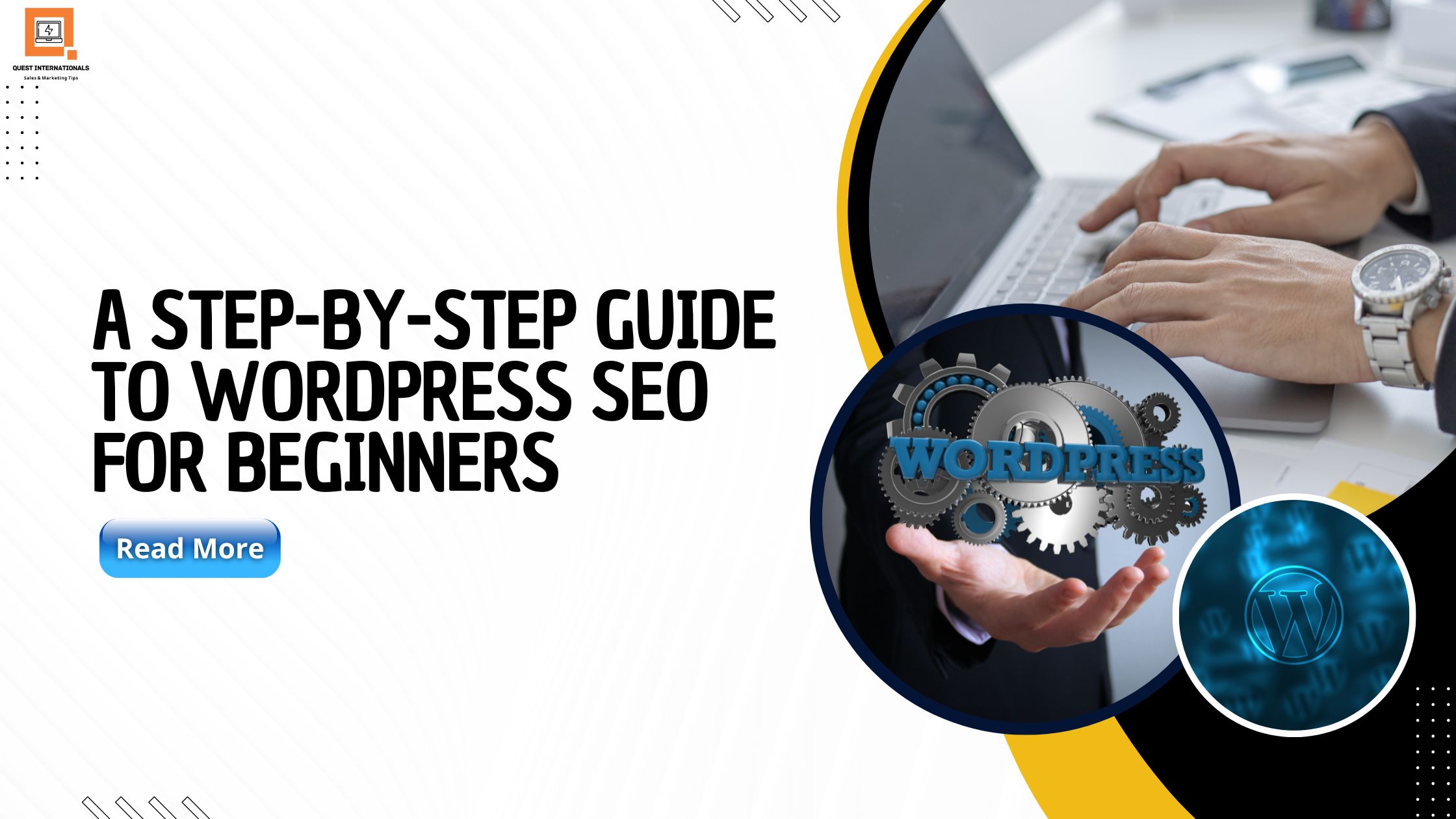Table of Contents
ToggleWordPress SEO refers to the process of optimizing a WordPress website to rank higher in search engine results pages (SERPs) for relevant keywords and phrases. When done correctly, WordPress SEO can help increase the visibility of a website and drive more organic traffic, which can ultimately lead to more leads, sales, and revenue. Navigating the world of WordPress SEO for beginners can be overwhelming, which is why a step-by-step guide can be helpful. In this guide, we’ll break down the process of WordPress SEO into simple, easy-to-follow steps, from choosing a domain name and hosting provider to optimizing content for search engines and building high-quality backlinks. By following these steps, even beginners can improve their WordPress website’s SEO and start seeing better results in search engine rankings.
WordPress SEO: The Ultimate Guide in 7Actionable Steps
If you’re running a website on WordPress, optimizing it for search engines is crucial to attract more traffic, generate leads, and boost your online presence. However, SEO can be a complex and time-consuming process, and with so many tactics and strategies out there, it’s easy to get overwhelmed. That’s why we’ve created this ultimate guide to WordPress SEO in 7 actionable steps.
Step 1: Choosing a Domain Name and Hosting for WordPress SEO Success
The domain name and hosting provider you choose for your WordPress website can have a significant impact on your website’s SEO performance.
Firstly, your domain name should be relevant to your website’s content and should ideally include your target keywords. This can help search engines understand what your website is about and improve its visibility in search results. Additionally, having a domain name that is memorable and easy to spell can also help attract more visitors to your website.
When it comes to hosting, there are several factors to consider. Your hosting provider should offer reliable and fast servers, as slow loading times can negatively impact your SEO. Additionally, your hosting provider should offer features such as SSL certificates, which can improve the security of your website and also boost its rankings in search results.
To select an SEO-friendly domain name and hosting provider, consider doing some research to compare different options and read reviews from other users. Look for providers that offer features specifically designed to improve SEO, such as automatic backups and built-in SEO optimization tools. By taking the time to choose the right domain name and hosting provider, you can set your WordPress website up for SEO success from the start.
Step 2: Installing WordPress and Setting Up Permalinks
Installing WordPress:
Installing WordPress is a straightforward process that can be completed in a few simple steps. Most web hosting providers offer an automated installation process that can be accessed from the control panel of your hosting account. Alternatively, you can download the WordPress installation files from the official website and upload them manually to your hosting account. Once WordPress is installed, you can log in to the dashboard and begin customizing your website.
Setting Up Permalinks:
Permalinks are the permanent URLs that point to your website’s individual pages and posts. They are important for SEO because they provide a clear structure for your website’s content and make it easier for search engines to crawl and index your pages.
To set up SEO-friendly permalinks in WordPress, go to the Settings menu in your WordPress dashboard and click on Permalinks. From there, you can choose from several different permalink structures, including the default structure, which uses a combination of numbers and letters, and custom structures that include post titles, categories, and dates.
To ensure that your permalinks are SEO-friendly, it’s important to choose a structure that is easy to read and includes your target keywords. For example, a structure that includes the post title and category can help both search engines and visitors understand what your content is about. Additionally, be sure to avoid using stop words such as “the” or “and” in your permalinks, as these can make them longer and more difficult to read. By setting up SEO-friendly permalinks, you can help improve your website’s visibility in search engine results in pages.
Step 3: Installing Essential Plugins for SEO
There are multiple best wordpress SEO plugins available to use. In addition to WordPress itself, there are several essential plugins that can help improve your website’s SEO. One of the most popular and comprehensive wordpress SEO plugins is Yoast SEO. This is one of the crucial part if you want you how to set up SEO for WordPress. This plugin offers a range of features to help optimize your website for search engines, including:
- Title and meta-description optimization
- XML sitemap generation
- Content analysis for SEO
- Canonical URL support
- Breadcrumb navigation
To install and configure the Yoast SEO plugin which is one of the best wordpress SEO plugins to use nowadays, go to the Plugins menu in your WordPress dashboard and click on Add New. Search for “Yoast SEO” and click Install, then Activate. From there, you can access the plugin’s settings by clicking on the SEO menu in your dashboard. Yoast SEO offers a step-by-step configuration wizard that can help you set up the plugin for your website’s specific needs.

Step 4: Keyword Research
Conducting thorough keyword research is an important step in optimizing your WordPress website for search engines. To begin your keyword research, start by brainstorming a list of potential keywords that are relevant to your website’s content and audience. You can also use keyword research tools such as Google Keyword Planner or SEMrush to generate keyword ideas and analyze their search volume and competition.
When choosing keywords for your website, it’s important to consider their relevance, search volume, and competition. Ideally, you want to choose keywords that are highly relevant to your website’s content and have a high search volume but are not too competitive. This can help improve your website’s visibility in search results and attract more organic traffic.
Once you have a list of target keywords, incorporate them strategically into your website’s content, including your page titles, meta descriptions, headings, and body text. However, it’s important to avoid “keyword stuffing,” or using your keywords excessively or unnaturally, as this can actually harm your website’s SEO performance.
By conducting thorough keyword research and strategically incorporating target keywords into your website’s content, you can help improve its visibility and ranking in search results and attract more organic traffic from search engines.
Step 5: Optimizing Content for SEO
Creating high-quality, SEO-friendly content is key to improving your website’s ranking in search results and attracting more organic traffic. Here are some best practices for optimizing your content for SEO:
Use your target keywords strategically: Incorporate your target keywords into your content, including your page titles, headings, and body text, but avoid keyword stuffing.
Create high-quality, engaging content: Write content that is informative, valuable, and engaging for your readers. This can help improve your website’s user experience and encourage visitors to stay on your website longer, which can also boost your SEO performance.
Use headings and subheadings: Use headings (H1, H2, H3, etc.) to structure your content and make it easier for readers and search engines to understand.
Optimize your meta descriptions: Use the Yoast SEO plugin to optimize your meta descriptions, which are the short snippets of text that appear in search results. A well-written meta description can help improve your click-through rate from search results.
Use internal and external links: Include internal links to other relevant pages on your website, as well as external links to high-quality, authoritative sources. This can help improve your website’s credibility and relevance.
To optimize your content using the Yoast SEO plugin, simply install and activate the plugin and create a new page or post. In the Yoast SEO section of the page or post editor, you can enter your target keyword and receive recommendations for optimizing your content, including your page title, meta description, headings, and body text.
Step 6: Building Backlinks
Backlinks, also known as inbound links or incoming links, link from other websites that point to your website. Backlinks are an important factor in SEO, as they can help improve your website’s authority, credibility, and ranking in search results. Here are some tips for building high-quality backlinks to your website:
- Create high-quality, shareable content: The best way to attract high-quality backlinks is to create content that is informative, valuable, and engaging for your audience. Shareable content, such as infographics, videos, and blog posts, are more likely to attract backlinks from other websites.
- Reach out to other websites: Find other websites in your niche or industry and reach out to them to request a backlink. You can do this by email or social media, and be sure to offer something of value in return, such as a guest blog post or a backlink from your website.
- Participate in online communities: Join online communities, such as forums or social media groups, related to your niche or industry, and participate in discussions. By sharing your knowledge and expertise, you can attract backlinks from other members of the community.
- Use directory listings: Submit your website to relevant directories, such as local business directories or industry-specific directories, to attract backlinks.
- Monitor your backlinks: Use tools such as Ahrefs or Moz to monitor your website’s backlinks and ensure that they are high-quality and relevant to your website’s content.
Building high-quality backlinks can take time and effort, but it is an important factor in improving your website’s SEO performance. By creating high-quality content, reaching out to other websites, participating in online communities, and using directory listings, you can attract high-quality backlinks to your website and improve its authority and credibility in search results.
Step 7: Monitoring and Improving Your SEO
Monitoring and improving your website’s SEO performance is an ongoing process that requires regular attention and effort. Here are some tips for monitoring your website’s SEO performance and improving it over time:
- Use Google Analytics: Google Analytics is a free tool that allows you to track key metrics related to your website’s SEO performance, such as organic traffic, bounce rate, and conversion rate. By monitoring these metrics, you can identify areas for improvement and track the effectiveness of your SEO efforts.
- Use other SEO tools: In addition to Google Analytics, there are many other SEO tools available that can help you monitor your website’s SEO performance, such as Ahrefs, SEMrush, and Moz. These tools can provide insights into your website’s backlinks, keyword rankings, and other important metrics.
- Conduct regular SEO audits: Conducting regular SEO audits of your website can help identify technical issues, such as broken links or duplicate content, that may be affecting your SEO performance. Use tools like Screaming Frog or SEMrush to crawl your website and identify any issues.
- Make data-driven improvements: Use the insights from your SEO monitoring and audits to make data-driven improvements to your website’s SEO. This may include optimizing your content, improving your website’s speed and performance, or building high-quality backlinks.
- Stay up-to-date with SEO best practices: SEO best practices are constantly evolving, so it’s important to stay up-to-date with the latest trends and strategies. Follow reputable SEO blogs and attend conferences to stay informed and improve your SEO skills.
By monitoring your website’s SEO performance and making regular improvements, you can improve your website’s ranking in search results and attract more organic traffic over time.
Conclusion
Whether you are a beginner or an experienced website owner, implementing SEO best practices is crucial to the success of your WordPress website. By following this step-by-step guide and keeping up with the latest SEO trends, you can achieve long-term success with your website and attract more visitors and customers. Are you tired of the same old marketing strategies that everyone else is using? Do you want to stay ahead of the competition and find new ways to engage your audience? Look no further than Marketing Enigma, the must-read magazine for marketers who want to think outside the box. Our team of expert writers and contributors is dedicated to bringing you the latest trends, insights, and ideas in marketing. From social media to SEO, from branding to content creation, we cover it all. Check out the magazine today!





